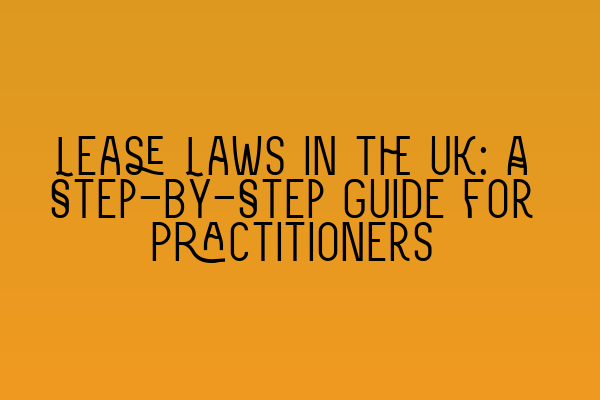Lease Laws in the UK: A Step-by-Step Guide for Practitioners
Lease laws in the UK play a crucial role in governing the relationship between landlords and tenants. As a practitioner in property and land law, it is essential to have a comprehensive understanding of lease laws to provide effective legal advice and representation. In this step-by-step guide, we will delve into the intricacies of lease laws in the UK, discussing key concepts, legal requirements, and common issues practitioners may encounter.
1. Understanding Leases and Tenancy Agreements
Leases and tenancy agreements are legal contracts that outline the terms and conditions of a rental arrangement. It is crucial to understand the distinction between the two:
A lease refers to a longer-term agreement for a fixed period, typically longer than six months. It provides more extensive rights and protections to both landlords and tenants.
A tenancy agreement, on the other hand, is usually a shorter-term arrangement, commonly known as a “short-term lease” or a “tenancy-at-will.” It offers more flexibility but may provide fewer rights and protections compared to a lease.
When advising clients, it’s important to determine whether they are entering into a lease or a tenancy agreement, as this will impact the legal obligations and rights of all parties involved.
2. Essential Elements of a Lease
A lease typically contains several essential elements that must be included to ensure its validity and enforceability:
a. Parties Involved: The lease should clearly identify the landlord(s) and the tenant(s) by their full legal names. It’s crucial to ensure that all parties are capable of entering into a legal agreement.
b. Description of the Property: The lease must accurately describe the property being leased, including its location, size, and any other distinguishing features.
c. Term of the Lease: The lease should state the fixed period for which it will be in effect. This includes the start and end dates or any specific conditions that trigger the termination of the lease.
d. Rent and Payment Terms: The lease should clearly state the amount of rent, payment frequency, and accepted methods of payment. It is also essential to highlight any penalties or late fees for missed payments.
e. Repair and Maintenance Responsibilities: The lease must identify who is responsible for various aspects of property maintenance and repair, such as structural repairs, utilities, and general upkeep.
f. Rights and Obligations of the Parties: The lease should outline the rights and obligations of both the landlord and the tenant. This may include restrictions on modifying the property, subletting conditions, and requirements for giving notice when vacating the premises.
3. Legal Requirements for Leases
As a practitioner, it is crucial to ensure that any lease you draft or review complies with the legal requirements set forth by UK legislation. Some key legal requirements to consider include:
a. Formalities: A lease must be in writing and signed by all parties involved. Failure to meet this requirement may render the lease unenforceable.
b. Right to Rent Checks: Landlords must conduct right to rent checks on prospective tenants to ensure they have the legal right to rent in the UK. Familiarize yourself with the relevant legislation and guidelines to advise your clients accordingly.
c. Deposit Protection: Landlords are required to place tenant deposits in a government-approved tenancy deposit scheme. Ensure that your clients are aware of their obligations and the consequences of non-compliance.
d. Energy Performance Certificate (EPC): Landlords must provide tenants with an EPC, which outlines the energy efficiency rating of the property. This requirement is crucial for both residential and commercial leases.
4. Common Issues and Disputes
While following lease laws and legal requirements can help minimize disputes, issues may still arise. Some common lease-related issues that practitioners may encounter include:
a. Rent Arrears: Non-payment or late payment of rent is a prevalent issue. As a practitioner, you may be called upon to provide advice on eviction proceedings or negotiate repayment plans.
b. Repairs and Maintenance Disputes: Disagreements regarding the responsibility for repairs and property maintenance often lead to disputes. Being well-versed in the lease terms and relevant legislation allows you to advise your clients on their rights and obligations.
c. Illegal Subletting: Identifying and dealing with cases of illegal subletting require a thorough understanding of lease laws and the right processes to follow in such situations.
It is crucial to stay updated with recent case law and legislative changes to provide accurate and effective legal advice to your clients. Familiarize yourself with relevant resources such as our articles on Misrepresentation in Contracts, SQE Contract Law Syllabus, SQE Contract Law: Analyzing Landmark Cases and Influential Judicial Decisions, Understanding Contractual Capacity: Rights and Limitations, and Interactive SQE Mock Tests for Contract Law. These resources will complement your knowledge and enhance your understanding of lease laws and related legal concepts.
In conclusion, a thorough understanding of lease laws in the UK is essential for practitioners in property and land law. By familiarizing yourself with the fundamental elements of leases, legal requirements, and potential issues that may arise, you can provide effective legal advice and representation to clients. Stay updated on the latest developments in lease laws and related legal concepts to offer comprehensive and informed guidance in this complex area of law.
